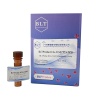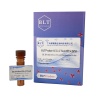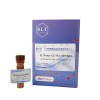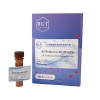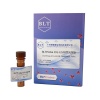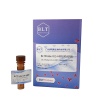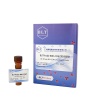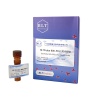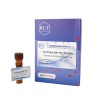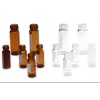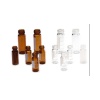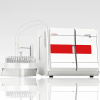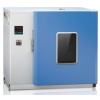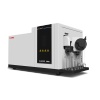


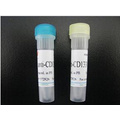
英文名称 Phospho-Smad3 (Ser208)
中文名称 磷酸化细胞信号转导分子SMAD3抗体
别 名 SMAD3(phospho S208); SMAD3(phospho Ser208); p-SMAD3(Ser208); hMAD 3; hSMAD3; HSPC193; JV15 2; JV152; MAD (mothers against decapentaplegic Drosophila) homolog 3; MAD3; MADH 3; MADH3; Mothers against decapentaplegic homolog 3; Mothers against DPP homolog 3; SMA and MAD related protein 3; SMAD 3; SMAD; SMAD-3; SMAD3_HUMAN.
磷酸化细胞信号转导分子SMAD3抗体
说 明 书 0.1ml
产品类型 磷酸化抗体
研究领域 肿瘤 细胞生物 免疫学 神经生物学 信号转导 干细胞 细胞凋亡 生长因子和激素
抗体来源 Rabbit
克隆类型 Polyclonal
交叉反应 Human, Mouse, Rat,
产品应用 WB=1:100-500 ELISA=1:500-1000 IP=1:20-100 IHC-P=1:100-500 IHC-F=1:100-500 ICC=1:100-500 IF=1:100-500 (石蜡切片需做抗原修复)
not yet tested in other applications.
optimal dilutions/concentrations should be determined by the end user.
分 子 量 47kDa
细胞定位 细胞核 细胞浆
性 状 Lyophilized or Liquid
浓 度 1mg/1ml
免 疫 原 KLH conjugated Synthesised phosphopeptide derived from human Smad3 around the phosphorylation site of Ser208 [NL(p-S)PN]
亚 型 IgG
纯化方法 affinity purified by Protein A
储 存 液 0.01M PBS, pH 7.4 with 10 mg/ml BSA and 0.1% Sodium azide
保存条件 Store at -20 °C for one year. Avoid repeated freeze/thaw cycles. The lyophilized antibody is stable at room temperature for at least one month and for greater than a year when kept at -20°C. When reconstituted in sterile pH 7.4 0.01M PBS or diluent of antibody the antibody is stable for at least two weeks at 2-4 °C.
磷酸化细胞信号转导分子SMAD3抗体 产品介绍 background:
Smad3 is a 50 kDa member of a family of proteins that act as key mediators of TGF beta superfamily signaling in cell proliferation, differentiation and development. The Smad family is divided into three subclasses: receptor regulated Smads, activin/TGF beta receptor regulated (Smad2 and 3) or BMP receptor regulated (Smad 1, 5, and 8); the common partner, (Smad4) that functions via its interaction to the various Smads; and the inhibitory Smads, (Smad6 and 7). Activated Smad3 oligomerizes with Smad4 upon TGF beta stimulation and translocates as a complex into the nucleus, allowing its binding to DNA and transcription factors. Phosphorylation of the two TGF beta dependent serines 423 and 425 in the C terminus of Smad3 is critical for Smad3 transcriptional activity and TGF beta signaling.
Function:
Receptor-regulated SMAD (R-SMAD) that is an intracellular signal transducer and transcriptional modulator activated by TGF-beta (transforming growth factor) and activin type 1 receptor kinases. Binds the TRE element in the promoter region of many genes that are regulated by TGF-beta and, on formation of the SMAD3/SMAD4 complex, activates transcription. Also can form a SMAD3/SMAD4/JUN/FOS complex at the AP-1/SMAD site to regulate TGF-beta-mediated transcription. Has an inhibitory effect on wound healing probably by modulating both growth and migration of primary keratinocytes and by altering the TGF-mediated chemotaxis of monocytes. This effect on wound healing appears to be hormone-sensitive. Regulator of chondrogenesis and osteogenesis and inhibits early healing of bone fractures (By similarity). Positively regulates PDPK1 kinase activity by stimulating its dissociation from the 14-3-3 protein YWHAQ which acts as a negative regulator.
Subunit:
Monomer; in the absence of TGF-beta. Homooligomer; in the presence of TGF-beta. Heterotrimer; forms a heterotrimer in the presence of TGF-beta consisting of two molecules of C-terminally phosphorylated SMAD2 or SMAD3 and one of SMAD4 to form the transcriptionally active SMAD2/SMAD3-SMAD4 complex. Interacts with TGFBR1. Part of a complex consisting of AIP1, ACVR2A, ACVR1B and SMAD3. Interacts with AIP1, TGFB1I1, TTRAP, FOXL2, PML, PRDM16, HGS and WWP1. Interacts (via MH2 domain) with CITED2 (via C-terminus) (By similarity). Interacts with NEDD4L; the interaction requires TGF-beta stimulation (By similarity). Interacts (via the MH2 domain) with ZFYVE9. Interacts with HDAC1, VDR, TGIF and TGIF2, RUNX3, CREBBP, SKOR1, SKOR2, SNON, ATF2, SMURF2 and TGFB1I1. Interacts with DACH1; the interaction inhibits the TGF-beta signaling. Forms a complex with SMAD2 and TRIM33 upon addition of TGF-beta. Found in a complex with SMAD3, RAN and XPO4. Interacts in the complex directly with XPO4. Interacts (via the MH2 domain) with LEMD3; the interaction represses SMAD3 transcriptional activity through preventing the formation of the heteromeric complex with SMAD4 and translocation to the nucleus. Interacts with RBPMS. Interacts (via MH2 domain) with MECOM. Interacts with WWTR1 (via its coiled-coil domain). Interacts (via the linker region) with EP300 (C-terminal); the interaction promotes SMAD3 acetylation and is enhanced by TGF-beta phosphorylation in the C-terminal of SMAD3. This interaction can be blocked by competitive binding of adenovirus oncoprotein E1A to the same C-terminal site on EP300, which then results in partially inhibited SMAD3/SMAD4 transcriptional activity. Interacts with SKI; the interaction represses SMAD3 transcriptional activity. Component of the multimeric complex SMAD3/SMAD4/JUN/FOS which forms at the AP1 promoter site; required for syngernistic transcriptional activity in response to TGF-beta. Interacts (via an N-terminal domain) with JUN (via its basic DNA binding and leucine zipper domains); this interaction is essential for DNA binding and cooperative transcriptional activity in response to TGF-beta. Interacts with PPM1A; the interaction dephosphorylates SMAD3 in the C-terminal SXS motif leading to disruption of the SMAD2/3-SMAD4 complex, nuclear export and termination of TGF-beta signaling. Interacts (dephosphorylated form via the MH1 and MH2 domains) with RANBP3 (via its C-terminal R domain); the interaction results in the export of dephosphorylated SMAD3 out of the nucleus and termination of the TGF-beta signaling. Interacts with MEN1. Interacts with IL1F7. Interaction with CSNK1G2. Interacts with PDPK1 (via PH domain).
Subcellular Location:
Cytoplasm. Nucleus. Note=Cytoplasmic and nuclear in the absence of TGF-beta. On TGF-beta stimulation, migrates to the nucleus when complexed with SMAD4. Through the action of the phosphatase PPM1A, released from the SMAD2/SMAD4 complex, and exported out of the nucleus by interaction with RANBP1. Co-localizes with LEMD3 at the nucleus inner membrane. MAPK-mediated phosphorylation appears to have no effect on nuclear import. PDPK1 prevents its nuclear translocation in response to TGF-beta.
Post-translational modifications:
Phosphorylated on serine and threonine residues. Enhanced phosphorylation in the linker region on Thr-179, Ser-204 and Ser-208 on EGF AND TGF-beta treatment. Ser-208 is the main site of MAPK-mediated phosphorylation. CDK-mediated phosphorylation occurs in a cell-cycle dependent manner and inhibits both the transcriptional activity and antiproliferative functions of SMAD3. This phosphorylation is inhibited by flavopiridol. Maximum phosphorylation at the G(1)/S junction. Also phosphorylated on serine residues in the C-terminal SXS motif by TGFBR1 and ACVR1. TGFBR1-mediated phosphorylation at these C-terminal sites is required for interaction with SMAD4, nuclear location and transactivational activity, and appears to be a prerequisite for the TGF-beta mediated phosphorylation in the linker region. Dephosphorylated in the C-terminal SXS motif by PPM1A. This dephosphorylation disrupts the interaction with SMAD4, promotes nuclear export and terminates TGF-beta-mediated signaling. Phosphorylation at Ser-418 by CSNK1G2/CK1 promotes ligand-dependent ubiquitination and subsequent proteasome degradation, thus inhibiting SMAD3-mediated TGF-beta responses. Phosphorylated by PDPK1.
Acetylation in the nucleus by EP300 in the MH2 domain regulates positively its transcriptional activity and is enhanced by TGF-beta.
Ubiquitinated.
DISEASE:
Defects in SMAD3 may be a cause of colorectal cancer (CRC) [MIM:114500].
Defects in SMAD3 are the cause of Loeys-Dietz syndrome type 1C (LDS1C) [MIM:613795]. LDS1C is an aortic aneurysm syndrome with widespread systemic involvement. The disorder is characterized by the triad of arterial tortuosity and aneurysms, hypertelorism, and bifid uvula or cleft palate. Patients with LDS1C also manifest early-onset osteoarthritis. They lack craniosynostosis and mental retardation.
Similarity:
Belongs to the dwarfin/SMAD family.
Contains 1 MH1 (MAD homology 1) domain.
Contains 1 MH2 (MAD homology 2) domain.
Gene ID:
4088
Database links:
Entrez Gene: 4088 Human
Entrez Gene: 17127 Mouse
Entrez Gene: 25631 Rat
Omim: 603109 Human
SwissProt: P84022 Human
SwissProt: Q8BUN5 Mouse
SwissProt: P84025 Rat
Unigene: 727986 Human
Unigene: 7320 Mouse
Unigene: 10636 Rat
Important Note:
This product as supplied is intended for research use only, not for use in human, therapeutic or diagnostic applications.
磷酸化细胞信号转导分子SMAD3抗体
hz-3114R Phospho-Dab1 (Tyr220) 磷酸化Disabled 1抗体
hz-3115R Phospho-Dab1 (Tyr232) 磷酸化Disabled 1抗体
hz-3116R Phospho-Dab1 (Ser491) 磷酸化Disabled 1抗体
hz-3659R DACH2 转录调节因子DACH2抗体
hz-2762R DARPP32 多巴胺、cAMP调节磷蛋白抗体
hz-3118R Phospho-DARPP32(Thr34) 磷酸化多巴胺/cAMP调节神经磷蛋白抗体
hz-3119R Phospho-DARPP32(Thr75) 磷酸化多巴胺/cAMP调节磷蛋白抗体
hz-2332R DGAT1/Diglyceride acyltransferase 二脂酰甘油酰基转移酶抗体
hz-1007R DRD1 多巴胺受体D1抗体
hz-5825R PCDHA12 原钙粘蛋白12抗体
hz-5826R PCDHAC1 原钙粘蛋白1抗体
hz-1008R DRD2 多巴胺受体D2抗体
hz-1743R DRD3 多巴胺受体D3抗体
hz-1714R DAT/Dopamine transporter 多巴胺转运蛋白DAT抗体
hz-1746R DRD4 多巴胺受体D4抗体
hz-1747R DRD5/Dopamine receptor 5 多巴胺受体D5抗体
hz-2761R DBC1/deleted in bladder cancer 1 膀胱癌缺失基因1
hz-3117R Phospho-DBC1 (Thr454) 磷酸化膀胱癌缺失基因1抗体
hz-0596R DBH 多巴胺β羟化酶抗体
hz-5827R PCDHGB5 原钙粘蛋白γB5抗体
hz-3674R PBR/DBI/TSPO 外周苯二氮受体抗体
hz-0592R DCC 结肠直肠癌缺失基因抗体
hz-2564R DCIR/CLEC4A C型凝集素结构域家族4成员A抗体
hz-1695R DCN/Decorin 核心蛋白聚糖抗体
hz-2663R CLEC5A/MDL1 C型凝集素结构域家族5成员A抗体
hz-2556R LAMP-3/DC-LAMP/CD208 溶酶体相关膜蛋白3抗体
hz-2557R DC-SIGN/CD209 细胞间粘附分子非整合素蛋白3抗体
hz-2239R DC-SIGN/CD209 细胞间粘附分子非整合素蛋白3抗体
hz-2563R DC-SIGNR/CD299 CD299抗体
hz-2565R DEC-205/CD205/Ly75 淋巴细胞抗原75抗体
hz-5056R DECR1 线粒体2,4-双烯酰辅酶A还原酶1抗体
hz-5843R PCDHB11 原钙粘蛋白β11抗体
hz-4057R DEGS1 退行性精母细胞同源物1抗体
hz-1037R DCP 异常凝血酶原/脱-γ-羧基凝血酶原抗体
hz-5828R PCDHB13 原钙粘蛋白13抗体
hz-5057R DHCR7 7脱氢胆固醇还原酶抗体


